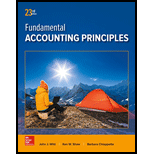
Concept explainers
Introduction:
Fixed and variable costs:
Fixed costs are costs that remains constant and do not fluctuate with the change in activity volumes or production. The increase or decrease in activity volume or production does not impact the cost as the fixed cost is associated with the product. Indirect costs and factory
Variable costs are costs that fluctuates with the activity volume or production. The cost varies with the level of change in activity volume or production. Increase in activity or production leads to increase in total costs and decreased activity or production leads to reduction in total costs. Examples of variable costs include wages paid to labor, sales commission etc. Variable costs are helpful in decision-making process by managers in production process.
To state:
The classification of cost whether variable or fixed based on the description of product costs for the production of footballs.
Want to see the full answer?
Check out a sample textbook solution
Chapter 18 Solutions
Fundamental Accounting Principles
- 4500 bonds with a face value of $1000 each, are sold at 101. The entry to record the issuance is Cash Premium on Bonds Payable Bonds Payable 4545000 45000 4500000 Cash 4545000 Bonds Payable 4545000 Cash Premium on Bonds Payable Bonds Payable Cash Discount on Bonds Payable Bonds Payable 4500000 45000 4545000 4545000 45000 4500000arrow_forwardQuick answer with accountingarrow_forwardWildhorse Home Supply Company received proceeds of $690000 on 10-year, 7% bonds issued on January 1, 2025. The bonds had a face value of $736000, pay interest annually on December 31, and have a call price of 101. Wildhorse Home Supply uses the straight- line method of amortization. What is the amount of interest Wildhorse Home Supply will pay bondholders in 2025? ○ $48300 $56120 ○ $51520 ○ $46920arrow_forward
- Can you help me with General accounting question?arrow_forwardPlease show me the valid approach to solving this financial accounting problem with correct methods.arrow_forwardBonds with a face value of $400000 and a quoted price of 101.25 have a selling price of $404100. ○ $405000. ○ $404010. ○ $440500.arrow_forward
- Please provide the answer to this general accounting question using the right approach.arrow_forwardI am trying to find the accurate solution to this general accounting problem with the correct explanation.arrow_forwardA cash register reading shows cash sales of $6600 and sales taxes of $330. The journal entry to record this information is Cash Sales Tax Revenue Sales Revenue Cash Sales Revenue Sales Taxes Payable 6930 330 6600 6930 6600 330 Cash 6600 Sales Tax Expense 330 Sales Revenue 6930 Cash 6600 Sales Revenue 6600arrow_forward
- What makes you think you can put up with the stress, pressure, and long hours of a career in finance?arrow_forwardI need my problem with accountingarrow_forwardOn January 1, 2025, Ivanhoe Company, a calendar-year company, issued $1760000 of notes payable, of which $440000 is due on January 1 for each of the next four years. The proper balance sheet presentation on December 31, 2025, is Current liabilities, $1760000. ○ Current liabilities, $440000; Long-term Debt, $880000. Current liabilities, $440000; Long-term Debt, $1320000. ○ Long-term debt, $1760000.arrow_forward

 AccountingAccountingISBN:9781337272094Author:WARREN, Carl S., Reeve, James M., Duchac, Jonathan E.Publisher:Cengage Learning,
AccountingAccountingISBN:9781337272094Author:WARREN, Carl S., Reeve, James M., Duchac, Jonathan E.Publisher:Cengage Learning, Accounting Information SystemsAccountingISBN:9781337619202Author:Hall, James A.Publisher:Cengage Learning,
Accounting Information SystemsAccountingISBN:9781337619202Author:Hall, James A.Publisher:Cengage Learning, Horngren's Cost Accounting: A Managerial Emphasis...AccountingISBN:9780134475585Author:Srikant M. Datar, Madhav V. RajanPublisher:PEARSON
Horngren's Cost Accounting: A Managerial Emphasis...AccountingISBN:9780134475585Author:Srikant M. Datar, Madhav V. RajanPublisher:PEARSON Intermediate AccountingAccountingISBN:9781259722660Author:J. David Spiceland, Mark W. Nelson, Wayne M ThomasPublisher:McGraw-Hill Education
Intermediate AccountingAccountingISBN:9781259722660Author:J. David Spiceland, Mark W. Nelson, Wayne M ThomasPublisher:McGraw-Hill Education Financial and Managerial AccountingAccountingISBN:9781259726705Author:John J Wild, Ken W. Shaw, Barbara Chiappetta Fundamental Accounting PrinciplesPublisher:McGraw-Hill Education
Financial and Managerial AccountingAccountingISBN:9781259726705Author:John J Wild, Ken W. Shaw, Barbara Chiappetta Fundamental Accounting PrinciplesPublisher:McGraw-Hill Education





